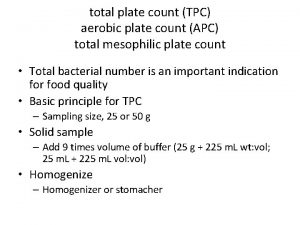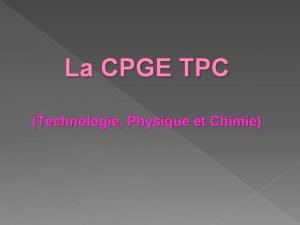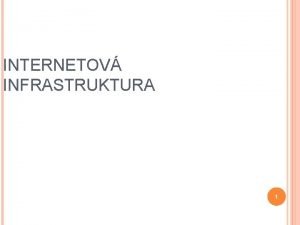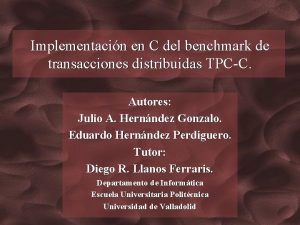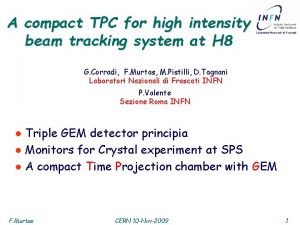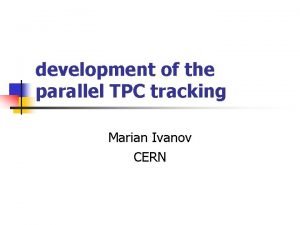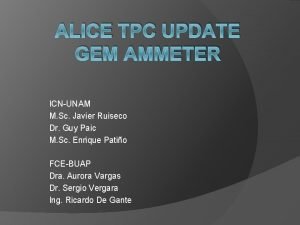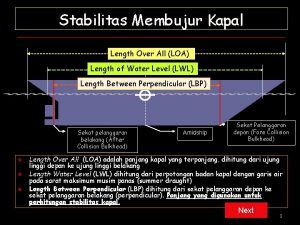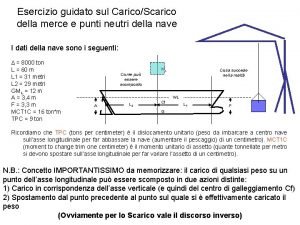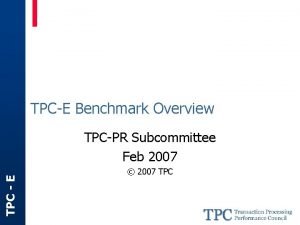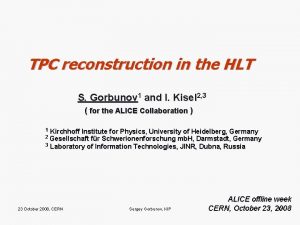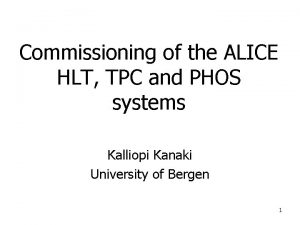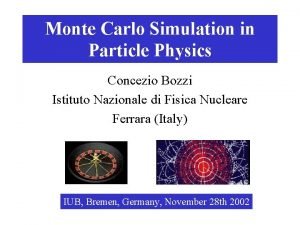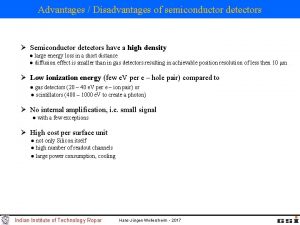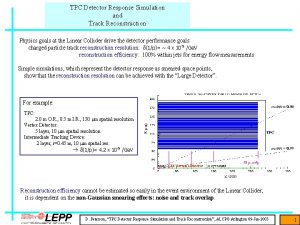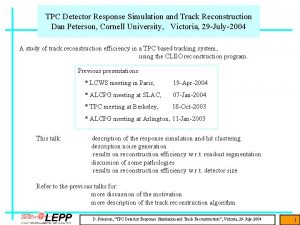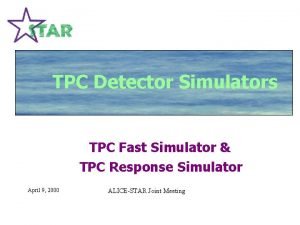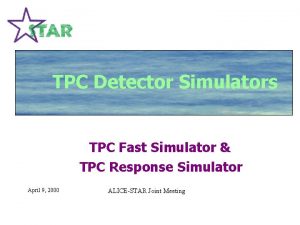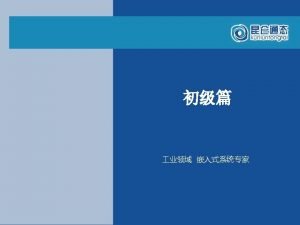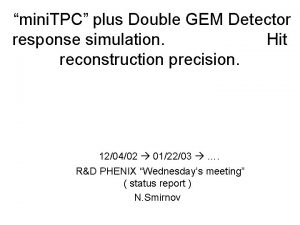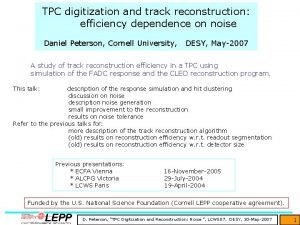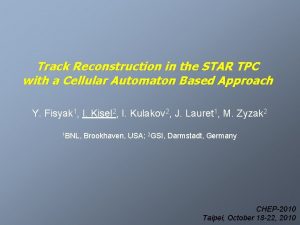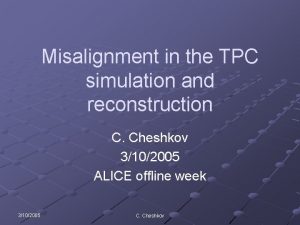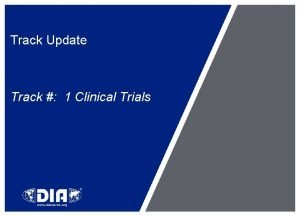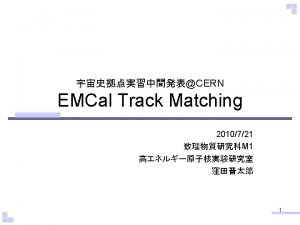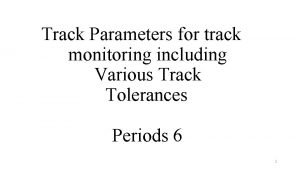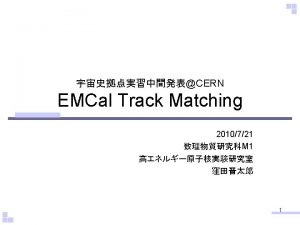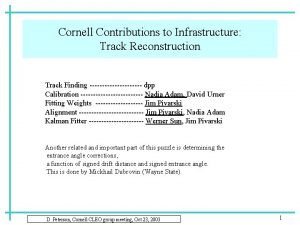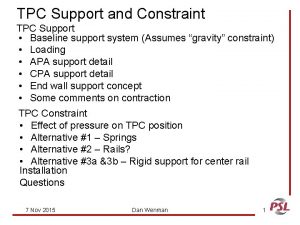TPC Detector Response Simulation and Track Reconstruction Physics






















- Slides: 22

TPC Detector Response Simulation and Track Reconstruction Physics goals at the Linear Collider drive the detector performance goals: charged particle track reconstruction resolution: d(1/p)= ~ 4 x 10 -5 /Ge. V reconstruction efficiency: 100% within jets for energy flow measurements Simple simulations, which represent the detector response as smeared space points, show that the reconstruction resolution can be achieved with the “Large Detector”. For example: TPC: 2. 0 m O. R. , 0. 5 m I. R. , 150 mm spatial resolution Vertex Detector: 5 layer, 10 mm spatial resolution Intermediate Tracking Device: 2 layer, r=0. 45 m, 10 mm spatial res. d(1/p)= 4. 2 x 10 -5 /Ge. V Reconstruction efficiency cannot be estimated so easily in the event environment of the Linear Collider, it is dependent on the non-Gaussian smearing effects: noise and track overlap. D. Peterson, “TPC Detector Response Simulation and Track Reconstruction”, ALCPG Arlington 09 -Jan-2003 1

Reconstruction Efficiency While reconstruction efficiency is difficult to measure, one could achieve the maximum efficiency with the maximum possible segmentation. However, the channel count would be excessive (and expensive); [ 1 cm x 1 mm pads ] 2. 4 x 106 multi-hit channels. To build the optimal detector, measure the reconstruction efficiency with respect to the detector segmentation, determine the minimum segmentation that provides the “full” efficiency. The goal of this work is to measure the reconstruction efficiency and optimize the design for a TPC in the “Large Detector” design, incorporating as many real detector effects as possible ( pad size, charge spreading, inefficient pads, noise ), for complicated physics events simulating Linear Collider processes, and using pattern recognition that starts with pad level information. Many thanks to Mike Ronan for wrapping the Cornell reconstruction code in Java and providing a access to lcd simulation events in. sio format. D. Peterson, “TPC Detector Response Simulation and Track Reconstruction”, ALCPG Arlington 09 -Jan-2003 2

Sample event with 2 mm pads Sample event from lcd simulation (All hits are projected onto one endplate. ) 144 layers from 56 cm to 200 cm 2 mm wide pads (number of pads in layer is multiple of 8) no charge spread no z overlap no noise This would be similar to a situation with 1 mm pads and charge spreading to 2 pads, a very expensive detector. Reconstruction looks almost possible even without using z information of the hits. Possibly, when using the z information, a larger pad size can provide full reconstruction efficiency. D. Peterson, “TPC Detector Response Simulation and Track Reconstruction”, ALCPG Arlington 09 -Jan-2003 3

Sample Event, Tracks within a Jet (Same event, same pad response ) Tracks in a jet are usually separated. Again, it appears that, when taking advantage of the z separation, the reconstruction task would be simple. D. Peterson, “TPC Detector Response Simulation and Track Reconstruction”, ALCPG Arlington 09 -Jan-2003 4

Sample Event, Problem with Overlapping Tracks (Same event, same pad response ) However, z separation is often too small to be useful for track separation. extreme example: for these two tracks cross in r-f, and z-separation is only 1 mm. But, track reconstruction can be efficient for very close tracks by using information from regions where the tracks are isolated. This is an advantage of the pat. rec. to be described. D. Peterson, “TPC Detector Response Simulation and Track Reconstruction”, ALCPG Arlington 09 -Jan-2003 5

Detector Simulation: Pad Response ( and Clustering ) Charge spreading, relative to the lcd crossing point, is defined by parameters in the simulation. Gaussian width of the charge distribution pads share the charge sum (miniumum ionizing) in the layer according to the distance of the pad center from the crossing point of the track with the layer. (future: integrate the distribution function across the pad. ) No charge is deposited below a cut-off (~. 002 of min. ion. ) There is also a total-number-of-pads maximum. The charge is renormalized to provide a total of min. ion. Clusters are formed after determining the time overlap of the pulses. Require Central pad with pulse height above ( ~0. 20 min. ion. ) Adjacent pads are added to the cluster, require pulse height > ( ~0. 01 min. ion. ) and Dt < (1 ms (or 5 cm)) Clusters are split at a local minimum, require pulse height (min) < 0. 49 of the lesser maxima, can lead to pulse height merging and incorrect clustering. Pads with > 0. 51 of the maximum are treated as “core pads”. (a detail of the primary pattern recognition) D. Peterson, “TPC Detector Response Simulation and Track Reconstruction”, ALCPG Arlington 09 -Jan-2003 6

Pad Response: Examples of Various Pad Width and Charge Spreading Width 4 figures illustrate the track separation for various combinations of the, separately tunable, pad size and charge spreading. (Note: these two tracks are separated by only 1 mm in z. 2 mm pads 1 mm s 2 mm pads 5 mm s 10 mm pads 1 mm s 10 mm pads 5 mm s The 2 mm pad with 5 mm spreading would provide excellent resolution but it is not clear that both these tracks would be reconstructed. The 10 mm pad with 5 mm spreading provides poor resolution and creates a challenge for reconstruction. However, this is the configuration being used for most of the reconstruction algorithm development. D. Peterson, “TPC Detector Response Simulation and Track Reconstruction”, ALCPG Arlington 09 -Jan-2003 7

Detector Response: Signal Time Overlap The TPC signal shape is affected by a rise time, and a decay time ( about 0. 4 ms (2 cm at 50 mm/ms. ) ). The pulse length has a contribution from the longitudinal spread of charge that is collected on a pad. (1 cm width, at cosq=0. 71 , for pads with 1 cm radial spacing ). Multiple signals on TPC pad will merge if separation is less than ~ 1 cm ( q dependent). Merged signals will result in lost, or distorted, hits on tracks. D. Peterson, “TPC Detector Response Simulation and Track Reconstruction”, ALCPG Arlington 09 -Jan-2003 8

Detector Response Simulation: Time Signal Overlap The basic pad pulse height is determined from the charge sharing of the available minimum ionization pulse shape rise time = 0. The pulse height is constant at the basic pad pulse height for a duration corresponding to the longitudinal spread. ( wrong, but treatment as a threshold device delays implementing a wave form analysis. ) ( 1 cm charge spread, 50 mm/ms ; ~ 200 ns ) The pulse height decays with a characteristic time. (400 ns). Noise Pulses: duration = 2 cm, and pulse height between 0 and 2 min. ion. Merging of time overlapped hits on the same pad Individual signals may be deleted, based on time separation. Multiple signals are collected on each of the pads. Signals are accepted if the pulse height sum from all earlier signals ( the instantaneous pedestal) is less than 0. 30 of the candidate signal (Dirty laundry: This treatment is not yet complete; preceding small signals are not swallowed by larger signals. ) Recorded pulse height of a pad, as used in the r-f clustering, is the basic pulse height, increased by the pedestal. D. Peterson, “TPC Detector Response Simulation and Track Reconstruction”, ALCPG Arlington 09 -Jan-2003 9

Cluster Details D. Peterson, “TPC Detector Response Simulation and Track Reconstruction”, ALCPG Arlington 09 -Jan-2003 10

Track Reconstruction With a goal of accurately measuring the TPC pad size and spreading that will provide the “full” reconstruction efficiency in Linear Collider physics events, it becomes important to know that what is being measured is inherent reconstruction efficiency, limited by the track overlap and hit distortion, and NOT an efficiency that is limited by the algorithm. Require a means of independently determining the root cause of reconstruction failures. The CLEO reconstruction program include a diagnostics package that provides internal hit information and a graphics interface to the hit assignment, at intermediate stages in the programs. This allows rapid determination the root cause of reconstruction failures (on single tracks) and algorithm development. D. Peterson, “TPC Detector Response Simulation and Track Reconstruction”, ALCPG Arlington 09 -Jan-2003 11

CLEO Track Reconstruction The current CLEO charge particle track reconstruction originally written for a drift chamber (where z information is derived from the track and stereo layers) can be adapted to any type of device with dense hit information (like a TPC, but not silicon) (changes, including the treatment of 3 -dimensional hit information) are described later has been in constant development for 12 years 1999 adapted for an all-stereo drift chamber (rather than a mostly axial chamber) March 2002 upgrade treatment of decays-in-flight Oct 2002 upgrade for long range secondary vertices is highly efficient for overlapped tracks (as shown in the event ) because any region of track separation can be used as a seed has 3 stages 1. clean segment finding 2. initial track finding within the segment road 3. extension to more complicated regions (and other devices) D. Peterson, “TPC Detector Response Simulation and Track Reconstruction”, ALCPG Arlington 09 -Jan-2003 12

CLEO Pattern Recognition, First Stage for Track Reconstruction Contrast with the 3 -hit-seeded method: 3 hits are selected, maybe { inner, outer, middle } layers The 3 hits define a circle in the r-f view, and over-define the z projection. The seed helix can be qualified by the fit in the z projection. Hits that match the seed helix are selected inside a road. A road width is required at this stage with the width determined by the inherent detector resolution, non-gaussian smearing, track density; a wide road allows mis-reconstructions, a narrow road limits efficiency. CLEO-segment-finding method: Tracks are seeded by isolated segments; chains of hits isolated from other segments. All segments are identified and qualified by length and isolation. (In the 3 -hit-seeded method, seeds are limited those defined in the selected layers. ) in an environment of high track density use the 3 -dimensional information of the hits and use the characteristic that tracks point to the I. P. in interesting event. Segments are found in pre-selected, I. P. pointing, cones. While the 3 -hit-seeded method may be less constrained in z , the CLEO-segment-finding method is less constrained by self-selecting the cleanest hit segments. D. Peterson, “TPC Detector Response Simulation and Track Reconstruction”, ALCPG Arlington 09 -Jan-2003 13

Modifications to the CLEO Track Reconstruction The most obvious difference is that the hit information is different; a program written for a drift chamber is being adapted for a TPC. Drift chamber hits provide r-f information; z is derived from stereo layers using the residuals w. r. t. a track hypothesis. TPC hits provide r-f-z information directly. The required changes are hidden in the routines that calculate the r-f-z information for each hit. Once detector-type specific procedures are created, the change is transparent. The second difference is that TPC hits must be clustered to create an r-f-z point. Again, the required changes are hidden in the routines that calculate the r-f-z information for each hit. Most significant modification is to the multi-hit electronics used in a TPC. (Previous CLEO drift chambers are “small cell” chambers and are, therefore, single hit devices. ) Not an issue in a study using 3 -dimensional space points where the concept of a readout channel does not exist Pattern recognition using an existing track segment to predict other hits requires a mapping from channel to hits. A mapping between hits on the same electronics channel has been implemented along with the mapping between the hits belonging to a cluster. D. Peterson, “TPC Detector Response Simulation and Track Reconstruction”, ALCPG Arlington 09 -Jan-2003 14

Projected hits for event, after detector response simulation Same event as slide 3 10 mm pads, 7 mm charge spread Noise: 0. 003 occupancy in 3 -d volume 1 cm (r-f) x 2 cm (z) x layer Number of channels (1 side) 112 k Number of layer crossings 14946 Number of track hits = 51232 (each crossing creating ~ 3. 4 hits) Number of noise hits = 89385 Active cone: Z=[ r * (-6 / 80) ] +/- 3 cm ( will use wider cone in future ) Active hits in green Ignored hits in purple D. Peterson, “TPC Detector Response Simulation and Track Reconstruction”, ALCPG Arlington 09 -Jan-2003 15

Segment Finding Stage Active hits in green Ignored hits in purple Current isolated segment is shown in yellow Other isolated segments are shown in pink. At this point, processing for segments is not complete; not all segment are found. Merged tracks (at 7: 00) are found as one segment, interrupted when the tracks are ambiguous. The segment in the track at 1: 00 stops prematurely. From the diagnostics, there are too many double hits. (segment stage tuning variable) D. Peterson, “TPC Detector Response Simulation and Track Reconstruction”, ALCPG Arlington 09 -Jan-2003 16

After 2 nd Phase, r-f view Hits in road in orange. Hits on track in white. Although the track was found to small radius in the isolated segment stage, in the 2 nd stage, track is not found at low radius. r-f impact = 5. 6 mm The c 2 of the track is actually too good, c 2 = 6. ( hit resolution is 245 mm for 10 mm pads. ) Smearing of the pulse heights is incomplete; requires low-level electronic noise. D. Peterson, “TPC Detector Response Simulation and Track Reconstruction”, ALCPG Arlington 09 -Jan-2003 17

After 2 nd Phase, residual (r-f) view PLOT: residual on horizontal (+/- 0. 025 cm at edge) vs. radius on vertical 2 nd phase pattern recognition uses local residual correlations Radius is broken up into 16 parts In each radial part, look for correlated hits satisfying used r-f road < 0. 005 m used z road < 0. 10 m. Select best solution in each radial part. No solutions were found at low radius. Note other track. D. Peterson, “TPC Detector Response Simulation and Track Reconstruction”, ALCPG Arlington 09 -Jan-2003 18

After 2 nd Phase, z view Hits in road in orange. Hits on track in white. PLOT: Z on vertical (+/- 2. 5 meter ) vs. path length on horizontal The other track is also very close in Z. Below. 9 meter in arc length, the hits are merged and not usable, for either track, (at high resolution). Note: other track (interference) short tracks that escape the r-f road, curler, not completely in the r-f road D. Peterson, “TPC Detector Response Simulation and Track Reconstruction”, ALCPG Arlington 09 -Jan-2003 19

After 2 nd Phase, r-f view, 5 mm pad width Hits in road in orange. Hits on track in white. Now repeat the same track with 5 mm pads, 3. 5 mm charge spread The track is found extending to lower radius in the 2 nd stage. The c 2 of the track is still too good, c 2 = 1. 25 ( hit resolution is 111 mm for 5 mm pads. ) D. Peterson, “TPC Detector Response Simulation and Track Reconstruction”, ALCPG Arlington 09 -Jan-2003 20

After 2 nd Phase, residual (r-f) view, 5 mm pad width PLOT: residual on horizontal (+/- 0. 025 cm at edge) vs. radius on vertical 5 mm pads, 3. 5 mm charge spread 2 nd phase pattern recognition The track extends to lower radius. ( r-f impact = 80 mm) The other track is more distinct and also extends inward to the radius where the two track merge. For this track only, 10 mm pads is too large, 5 mm pads is sufficient. Plan: a statistical study of the relative efficiency vs. cell size and charge spread. D. Peterson, “TPC Detector Response Simulation and Track Reconstruction”, ALCPG Arlington 09 -Jan-2003 21

Outlook “Complete”: interface to the LCD physics simulation through. sio file (Mike Ronan) create a TPC geometry, data structure, and detector response simulation within the Cornell/CLEO reconstruction create the TPC specific x, y, z hit reconstruction routines upgrade the reconstruction to handle multi-hit electronics procedure for scanning through the I. P. pointing cones initial tune of roads for pattern recognition in TPC data Needed for efficiency studies: develop a method for identifying tracks that should be found have a list of hits organized by generator track number also have generated track in the. sio file would like to have events with a specific 2 body process, e. g. Z mm. for resolution: apply low level noise to all pulse heights, fraction of min. ion. Future results: efficiency and resolution vs. pad size and charge spread , and vs. 2 -track separation, P, and q D. Peterson, “TPC Detector Response Simulation and Track Reconstruction”, ALCPG Arlington 09 -Jan-2003 22
 Tpc total plate count
Tpc total plate count Prépa tpc montpellier
Prépa tpc montpellier Rand internet
Rand internet Tpc-c benchmark
Tpc-c benchmark Dock water allowance formula
Dock water allowance formula Tpc traking
Tpc traking Tpc kink
Tpc kink Tpc.msc
Tpc.msc Loa kapal
Loa kapal Dislocamento unitario tpc
Dislocamento unitario tpc Tpc-e benchmark
Tpc-e benchmark Tpc global tracking
Tpc global tracking Ecs commissioning
Ecs commissioning Natural response and forced response
Natural response and forced response Natural response circuit
Natural response circuit Primary immune response and secondary immune response
Primary immune response and secondary immune response Physics ia research question ideas
Physics ia research question ideas Concezio bozzi
Concezio bozzi Modern physics vs classical physics
Modern physics vs classical physics University physics with modern physics fifteenth edition
University physics with modern physics fifteenth edition Advantages and disadvantages of semiconductor detector
Advantages and disadvantages of semiconductor detector Securitization and reconstruction of financial assets
Securitization and reconstruction of financial assets Positives and negatives of reconstruction
Positives and negatives of reconstruction
